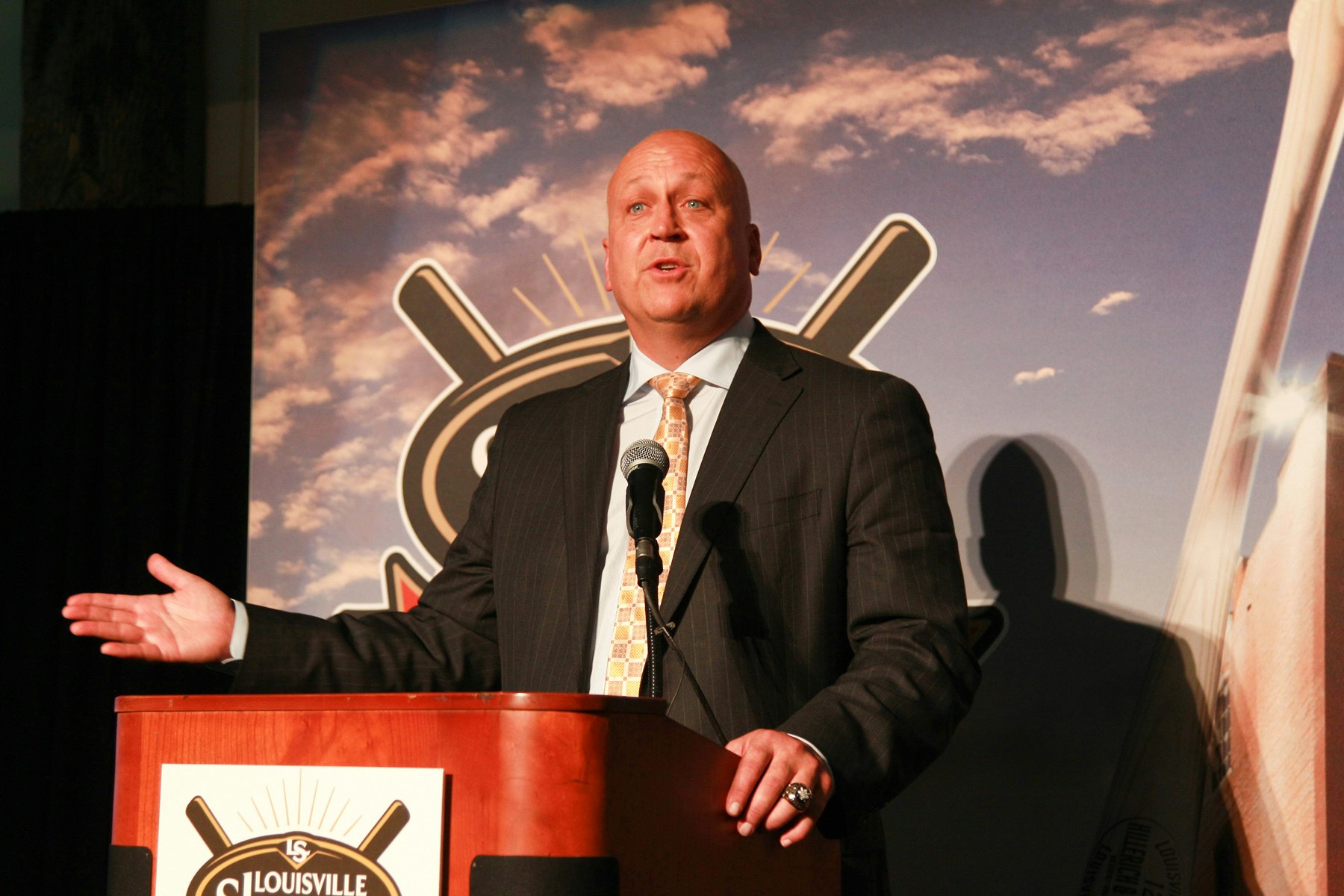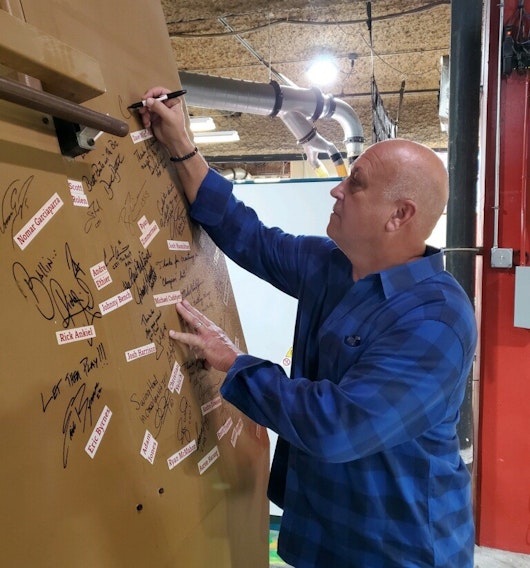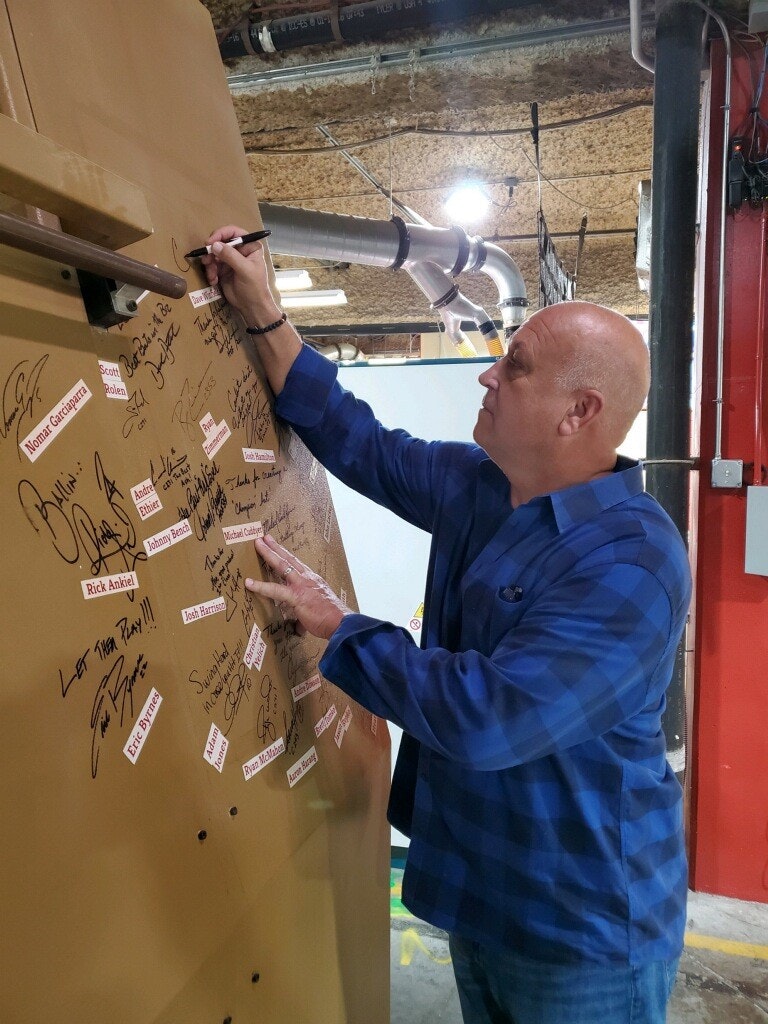On Tour With a Legend: Cal Ripken Jr. Visits Louisville Slugger Museum & Factory
By John Hughes
Cal Ripken Jr. is rearranging luggage in the family SUV at the end of a two-hour visit to Louisville Slugger Museum and Factory (LSMF). He’s got a load of travelling gear for himself, his wife Laura and family members. He makes easy work of unstacking and re-stacking and steps back from it to say something fairly profound when pondered for a minute . . .
“I wish I’d paid more attention to the details and precision of my bats when I was younger,” says the Hall of Fame shortstop.
This is Cal Ripken Jr. talking. He had 3,184 hits with Louisville Sluggers. (In the game’s 151 year history, only 32 players have reached 3,000 hits. And for those of you keeping score at home, more than 19,526 have played the game.) What if he’d “paid more attention”? What if da Vinci had been more careful mixing pigments?
By end of the Ripken family visit, his reflective comment seems in character of a man who, at 60 and 19 years retired from a 21-year playing career, is still fascinated by the fine points of bats and hitting. If you’re a baseball fan who also happens to be a LSMF tour guide, you’ve got pockets full of questions you’d like to ask one of the most respected players of The Game.
But on the tour, it’s Ripken who engages conversation as a learner rather than the baseball master that his stats prove him to be. He initiates a discussion about the number of grain lines per inch expected to prove a bat’s viability. (In Ted Williams’ day, six per inch, although Mickey Mantle sometimes specifically asked for bats with wider grain counts.) In the LSMF Bat Vault he wonders at some of the anomalous bat models including one that has a 9-degree curved handle. Asked if he can speculate on why a player would want a curved-handle bat, Ripken offers a couple possibilities, but ultimately chuckles: “I have no idea”.


Ripken is also interested in how finishes on bats have changed since his retirement in 2001. And he offers some insight on the matter by recounting how when he played shortstop and third base he found it more difficult to “find” the ball coming off a painted bat than a natural one.
Think about that casual detail for a minute. What he’s saying is that Major League infielders’ vision and reflexes are so precise, that something as simple as the color of a bat changes their reactions while making millisecond decisions. Ripken would know something about that . . .
If you’re in conversation with Cal Ripken Jr., and are reticent of the obvious, the title “Iron Man” never comes up. But to appreciate how many times he would have fielded a baseball off any kind of bat finish, remember this number first: 2,632. That’s how many games Ripken played without ever missing a start. And in the 2,977 total games he played, Ripken (officially) fielded a baseball 12,326 times, and made only 294 errors – meaning that 97 percent of the time he was not fooled by the finish of the bat nor the flight of the ball.
He was a complete player who, these years later, seems completely comfortable.
Cal Ripken Jr.’s name is on plaques and walls and his image hangs from the factory rafters along with other stars of baseball. In 2013 he was honored by Louisville Slugger as a “Living Legend” (pictured below) – an award based on a player’s performance, but also on his personal conduct. On tour, his family seems as much in awe as the rest of us at his impact on baseball.

In the museum archive room, the family passes around the Cal Ripken Jr. Louisville Slugger contract, like a piece of attic history. He was 18 when he signed. 6’3”. 185. He was paid $100 for signing, and got a set of golf clubs. He says he doesn’t remember the $100, but remembers the golf clubs. A hand-written note on the back of the contract says the clubs were “one inch longer than standard”.
His first bat was the M110 – the model made famous by Mickey Mantle. Over the years he swung Mel Ott, Frank Robinson, Eddie Murray, Stan Musial and Jose Cardenal and ordered 3,204 Louisville Sluggers.
But it is the model P72 that Ripken most identifies with. And as he and his family look at the original model inside the LSMF Bat Vault, they learn that the P72 is the only model – of more than 3,000 – that has ever been retired. (Derek Jeter used the P72 exclusively in 12,602 plate appearances. When Jeter retired, Louisville Slugger retired the model in his honor.)



Inside the factory, Ripken will always be linked to the P72. Like many great players before him, he autographed the CNC lathe that Hillerich & Bradsby uses to turn professional-grade Louisville Sluggers. “Trusted”, his mark on the machine reads, and he ends the inscription with “P72”.
Guests at LSMF see Cal Ripken Jr.’s fresh signature on our pro-bat computerized lathe.
“What’s he like?”, they ask.
“Just the way a baseball fan would want him to be,” is the easy answer.

